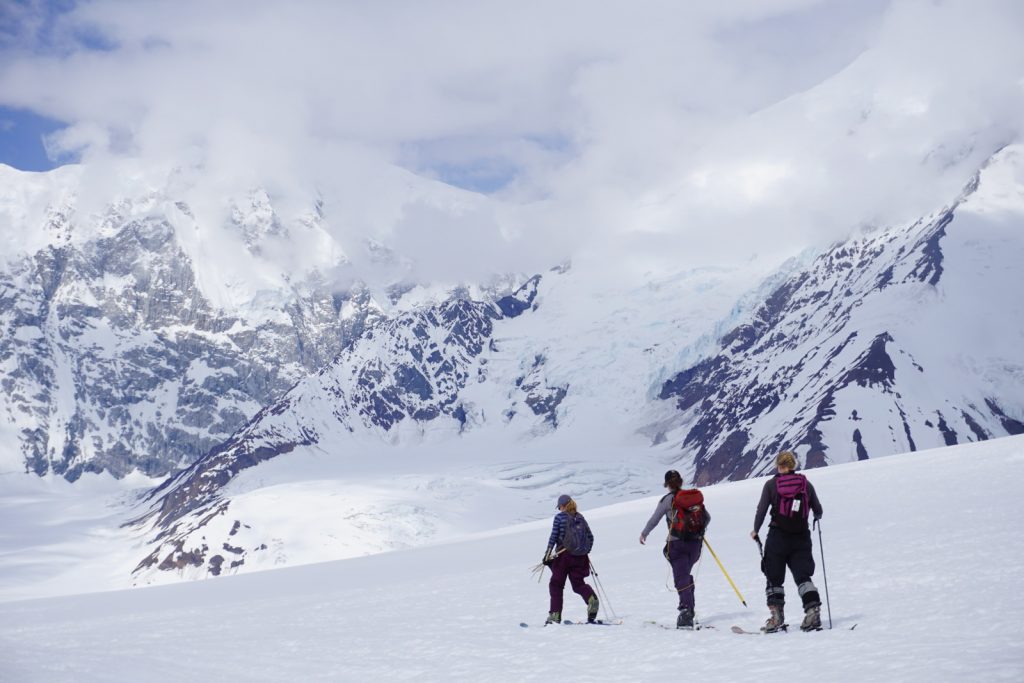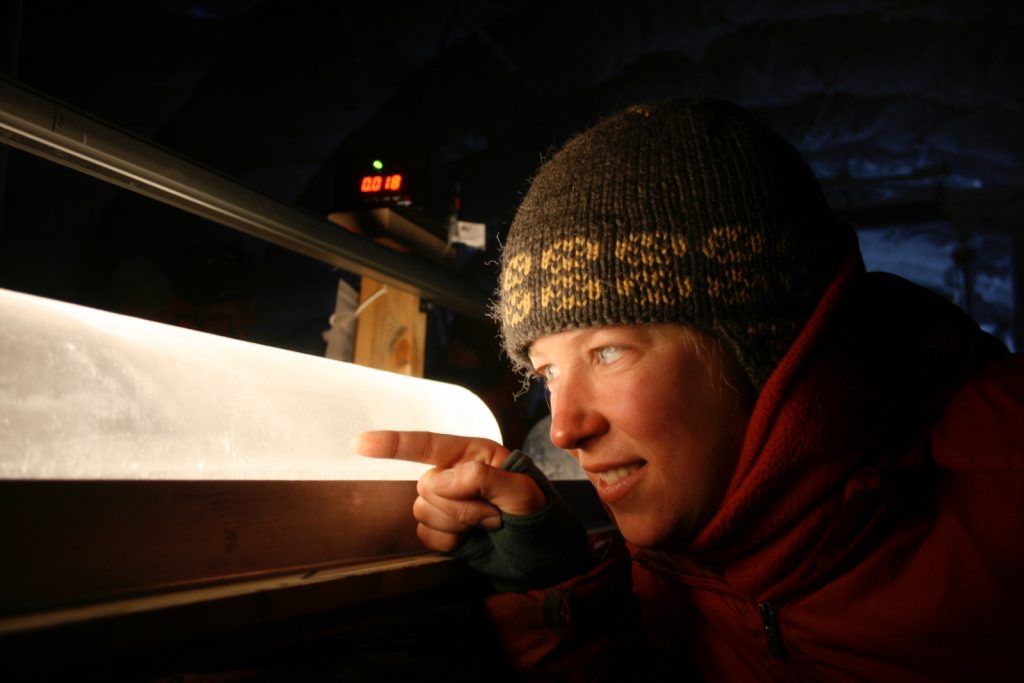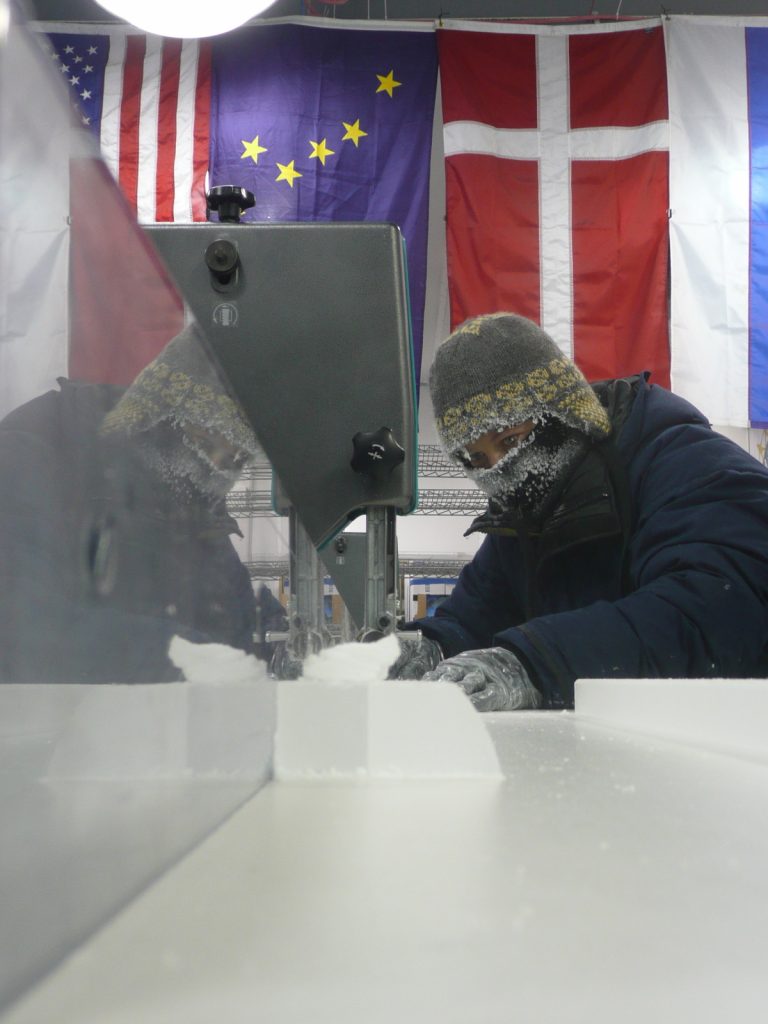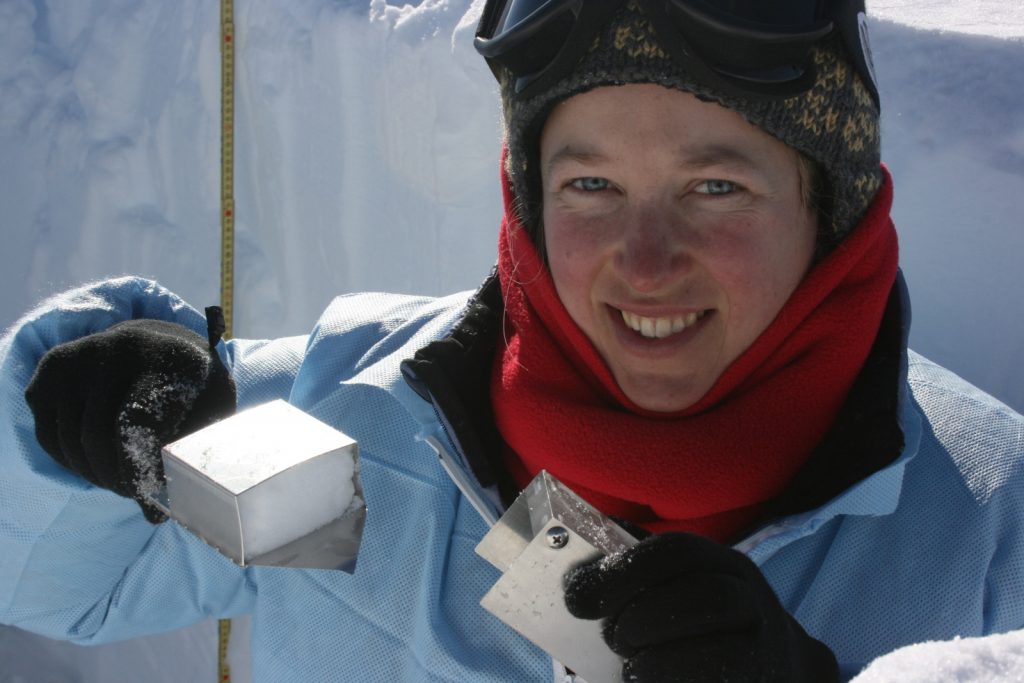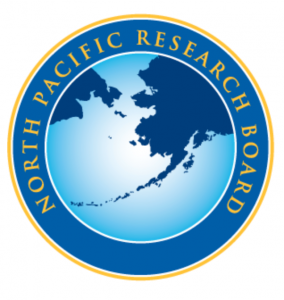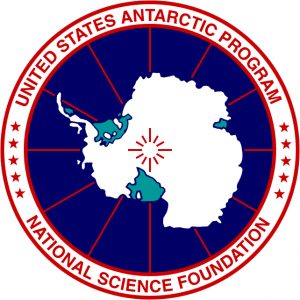Winds of change: using dust in Antarctic ice to understand past climates
Understanding prehistoric climates is key to understanding how our climate might change in the future and Antarctic ice cores provide fundamental information that forms the basis for much of this knowledge. Dr Bess Koffman, from Colby College, Waterville, Maine, in the US, studies the dust trapped in Antarctic ice, resolving where it came from and how it got there
TALK LIKE A GEOLOGIST
CLIMATE – the long-term (typically 30 years) average temperature, pressure, precipitation and other atmospheric conditions of a region
ICE CORE – a long cylinder of ice, extracted from ice sheets or glaciers, which helps scientists learn about past climatic and environmental conditions
ISOTOPE – a form of an element containing the same number of protons but a different number of neutrons. Some isotopes are stable and others are radioactive, meaning they decay through time. Because this decay occurs at a predictable rate, the products of radioactive decay can provide valuable insight into the age of Earth materials and the identity of dust source regions
PALAEOCLIMATE – the climate of the Earth or a certain region at a past point in geologic time
PLANKTON – microscopic organisms found in water that are critical for the functioning of aquatic ecosystems. Phytoplankton are photosynthetic, like plants, whereas zooplankton are tiny animals that eat bacteria, phytoplankton or each other!
The Earth’s climate is an exceedingly complex system, where temperatures, water, wind patterns, and masses, ocean currents and many other factors interact and affect one another. Climatic conditions are fundamentally determined by the Sun, which warms the earth’s surface. This warming is uneven, with different areas receiving varying amounts of heat because of the shape and tilt of the Earth. This is the principal reason for different climates and seasons around the world.
A key rule of physics is that heat energy moves from high-energy to low-energy areas. This is what drives winds and ocean currents, which move air and water from warmer areas near the equator toward the cooler poles. However, these patterns have not always existed exactly how we see them presently.
“During past climate changes, evidence suggests that the Earth’s wind belts changed in strength and location,” says Dr Bess Koffman. “By studying past changes using natural archives like ice cores, scientists like myself can learn what causes the Earth’s winds to shift. This in turn helps us better understand how wind patterns may change in the future.”
FROM DUST TO DUST
Bess is an Assistant Professor of Geology at Colby College, Waterville, Maine, in the US. One of her main projects involves extracting deep ice cores from Antarctica and then analysing the atmospheric dust trapped within them. “Dust gets picked up by winds from dusty places like deserts and mountain valleys,” says Bess. “Once in the atmosphere, it can get blown over the ocean and deposited in places such as the surface of the Antarctic ice sheet.” Over time, as more snow falls and ice forms, the dust becomes encased within the ice. Because dust that fell earlier will be lower down in the ice sheet, an extracted ice core provides a vertical ‘timeline’ with clues to what happened on the ice surface at different points in geologic history.
From the dust and other chemicals within ice cores, Bess is aiming to determine how winds have changed over time and what has driven these changes. “It’s important to remember that each palaeoclimate record only represents one location,” says Bess. “To decode whether our findings represent global or local patterns, we compare multiple ice core records from across Antarctica, as well as Arctic ice cores and other environmental records for the full global picture.”
TAKING AN ICE CORE
Ice can be extremely thick in Antarctica (up to nearly 5 km!), so extracting cores requires a significant amount of drilling. “An Antarctic ice core might be 1,500 to 3,000 metres long,” says Bess. “Each cylindrical ice core is drilled in short segments and then cut into metre-long ‘sticks’ that are analysed separately.” Because of the wealth of information contained within the ice, many different scientists from various labs will typically work on any individual core to ensure that maximum scientific value is extracted. “The technique I use to study dust is called a continuous melter system, which involves slowly melting each stick from one end towards the other, and extracting information on dust particle concentration and size within every millimetre using a particle counter,” says Bess.
For a several-kilometre-long ice core, this process can take a large team of people several months, but the information extracted is highly valuable. Ice cores are most famous for their usefulness in providing measurements of past carbon dioxide levels in the atmosphere. “By analysing the tiny bubbles of air trapped in ice, we know how carbon dioxide levels have changed over the past 800,000 years,” says Bess. “In addition to gases and dust, ice cores contain a variety of other chemicals, making them one of the most powerful environmental archives for learning about past climates.”
Although the end results can be very rewarding, Bess acknowledges the day-to-day lab work can be a grind. “Melting and analysing ice cores can be tedious work that is very detail-oriented,” she says. “Scientists must pay attention to many different components of the lab system to make sure everything is working. This takes a whole team of people, so communication and careful note-taking are of critical importance.”
EUREKA IN ALASKA
Bess’ work takes her to both poles, and a recent project in the Arctic culminated in some fascinating findings. “I used isotopes of certain elements in dust from snow in Alaska to investigate sources of dust and pollution,” she says. “The data showed that local glacial river valleys were important sources of dust at lower elevations. At higher altitudes, dust principally originated from the deserts of East Asia. The lead pollution in the Alaskan snow mainly came from metal smelting and coal burning in China.”
These findings have implications for people and the environment. Lead pollution can be toxic, especially for aquatic animals and growing children. “Over the past century, industrialisation in China has resulted in increased levels of lead pollution,” says Bess. “Although China has been working to reduce lead pollution, the data from Alaska shows that the Arctic region continues to be affected by industrial lead emissions, even after the global ban on leaded gasoline.”
Reference
https://doi.org/10.33424/FUTURUM291
FROM POLE TO POLE
Bess’ specialisations are relevant for many different research applications. “A current project of mine in Alaska is examining how volcanoes and dust sources affect ocean ecosystems by supplying nutrients such as iron to marine phytoplankton or algae,” she says. “In the northeast Pacific Ocean, phytoplankton growth is limited by a lack of iron, so an increase in iron deposition from dust or volcanic ash can boost their populations. Because these species form the base of the marine food web, this can have implications for the entire marine ecosystem.” Bess’ team is analysing the effects of volcanic ash and dust from Alaskan river valleys and Asian deserts on marine phytoplankton growth.
In Antarctica, Bess’ team’s research on dust sources continues. Bess hopes to use the composition of wind-blown dust to learn how the Antarctic ice cover may have changed in the past. “One potential application of this work is to learn whether the West Antarctic Ice Sheet collapsed during the Earth’s last interglacial warm period, about 125,000 years ago,” says Bess. “This will provide lessons for our current warm period, as climate change progresses. If this ice sheet did collapse in the last warm period, it may do so again, which would raise sea levels by up to six metres.” Such an increase in sea level would have dramatic implications on human populations; so, knowing what to expect and how to respond is critical.
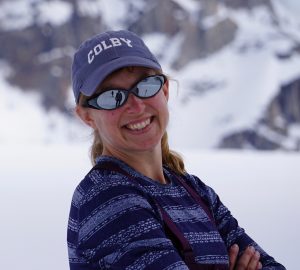 DR BESS KOFFMAN
DR BESS KOFFMAN
Assistant Professor of Geology
Colby College, Waterville, Maine, USA
FIELD OF RESEARCH
Paleoclimate Science, Geology
RESEARCH PROJECT
Studying polar ice cores to learn more about past climates, by examining the sources and concentrations of dust through time
FUNDERS
US National Science Foundation (NSF),
North Pacific Research Board,
American Association of University Women (AAUW)
ABOUT GEOLOGY
Geology is a broad discipline, involving the study of how the Earth’s systems work at present and worked in the past through a variety of clues from the environment. Bess explains more about what attracted her to the discipline, important skills for aspiring geologists and what to expect in the future. The Earth is everywhere around us and its systems intimately affect our well-being.
As an Earth scientist, I can study the air we breathe, the water we drink and the soil that nourishes our crops. Our world currently represents processes that have been interacting over hundreds of millions of years through the present, including the impacts of humans over the past few centuries. I love being able to study the dynamic interrelations within the biological, chemical and geological systems of the Earth.
Communicating science is fundamental. After robust scientific results have been developed, it is time to publish these findings. Scientists have to use persuasive language to explain why their interpretation makes sense, and this is an important skill for students to practice in their writing. Through evaluating evidence and mapping out arguments, students can practice this important aspect of scientific communication.
The expertise of geologists will be critical for the transition to clean energy. Understanding how to find and safely extract the elements needed for green technologies will play a key role in this shift. There are many geopolitical challenges to overcome as well, so the expertise of scientists will need to be included alongside international relations, economics and communication.
As our climate changes, clean fresh water will become increasingly scarce. Geologists can help society by quantifying different water sources, determining recharge rates and which resources are being overused. Contributing to these societal shifts will be challenging, but the next generation of geologists will be inherently broad thinkers with an important role to play.
EXPLORE CAREERS IN GEOLOGY
• Geology is a broad field, with opportunities for many different specialisations. Geologists work in various sectors, including academia, energy, consulting, resource extraction and natural hazards.
• Bess shares several resources for early career scientists interested in paleoclimate and cryosphere research. These include the Association of Polar Early Career Scientists (APECS, www.apecs.is), Ice Core Young Scientists (ICYS, pastglobalchanges.org/science/end-aff/icys) and the Polar Science Early Career Community Office (PSECCO, psecco.org).
• Colby College’s undergraduate courses are exciting gateways into geological careers. Undergraduates typically will conduct research in a professor’s lab including one summer of intensive research as part of their degree. Coursework sometimes involves engaging with younger students, for example, by doing outreach at local high schools. Also, many public talks and seminars happen regularly across campus.
Bess says that her broad scientific background in geology, chemistry and biology has helped her career, but notes that ice core scientists can come from a range of backgrounds, including maths and physics. For a typical geology degree, good courses to consider taking in high school are maths, chemistry, physics, biology, geology and geography.
Bess notes that writing and other communication skills are critical for science because scientists spend a significant amount of time applying for funding, communicating with other scientists and sharing findings with the public.
HOW DID BESS BECOME A GEOLOGIST?
WHAT WERE YOUR INTERESTS GROWING UP?
I loved horses as a child and wanted to be a large-animal veterinarian for a long time, even after my undergraduate studies in geology. However, when I learned that vets typically graduate with significant debt whereas PhD scientists get paid to go to graduate school, I decided to pursue scientific research instead. Other interests included anything outdoors. I loved swimming and being in the water. I would often climb trees, right to the top of huge fir trees near my house. I liked to collect rocks, shells and leaves, which perhaps reflected my early interest in geology.
WHAT INSPIRED YOU TO BECOME A GEOLOGIST?
While I was studying my undergraduate, Professor Richard Alley gave a visiting seminar describing the seminal ice core research done in Greenland in the 1990s, including how much we had learned about past climatic changes and how much more there was left to discover. I was hooked! After graduation, I found a job in Antarctica as a research technician, collecting ocean water samples to learn about the role of microorganisms in the ocean food web. After this amazing experience, I decided to apply to graduate school to study ice cores.
WHAT ATTRIBUTES HAVE HELPED YOU IN YOUR CAREER?
I am highly organised, have a strong work ethic and practice my communication skills. Working with other people inevitably involves challenging conversations and sometimes conflict resolution, so having strategies for these situations is useful. I worked as a wilderness trip leader before returning to graduate school, which I think helped me develop some of these skills.
WHAT ARE YOUR PROUDEST CAREER ACHIEVEMENTS SO FAR?
Landing my current job is a dream come true. I have awesome colleagues, I get to teach engaged and intelligent students and I have a lab where I can do rewarding work. I am grateful for the opportunities that led me to this point, and especially for the mentorship, guidance and support of my family, professors and schoolteachers.
HOW DO YOU DEAL WITH CHALLENGES AT WORK?
Sometimes tasks pile up and it can feel impossible to get everything done. Although my personal care suffers sometimes, I try to maintain healthy habits and regular sleep schedules. At work, being organised and delegating where appropriate help to keep everything on track, ensuring that I reach my long-term research goals despite all the short-term deadlines.
WHAT DO YOU DO WHEN YOU’RE NOT WORKING?
My young son keeps me busy! I also enjoy gardening and have a large vegetable garden and orchard. As well as spending time with my husband and friends, I play traditional New England and French-Canadian folk music on the fiddle. I also love being outdoors, especially in the winter months when I go skiing and ice skating as much as possible.
BESS’ TOP TIPS
01 Allow yourself to explore opportunities and see where they lead. It’s okay to try something out and find that a particular area of science doesn’t appeal to you. A summer job that you find you
don’t really like can save you from suffering through a PhD in that field. Everything is a learning experience.
02 Talk to people. Reach out to mentors. Email professors. If the people in your sphere know what you’re passionate about and what you are aiming for, they can more readily connect you with opportunities.
Do you have a question for Bess?
Write it in the comments box below and Bess will get back to you. (Remember, researchers are very busy people, so you may have to wait a few days.)



